Analyzing Organizational Communication for Business Success
VerifiedAdded on 2023/01/19
|8
|2045
|83
Report
AI Summary
This report delves into the multifaceted realm of business communication, commencing with a foundational definition of organizational communication and underscoring its pivotal role in organizational success. It explores diverse forms of communication, including formal, informal, internal, and external channels, and emphasizes their significance in fostering productivity, employee morale, and engagement. The report highlights the application of effective communication principles, such as completeness, clarity, and courtesy, to enhance business practices and improve organizational cooperation. It further examines various communication practices, including the dissemination of legal documents and the use of suggestion forms, to facilitate information flow and achieve organizational goals. The conclusion summarizes the benefits of effective communication and emphasizes the importance of communication principles in improving organizational cooperation and communication practices.
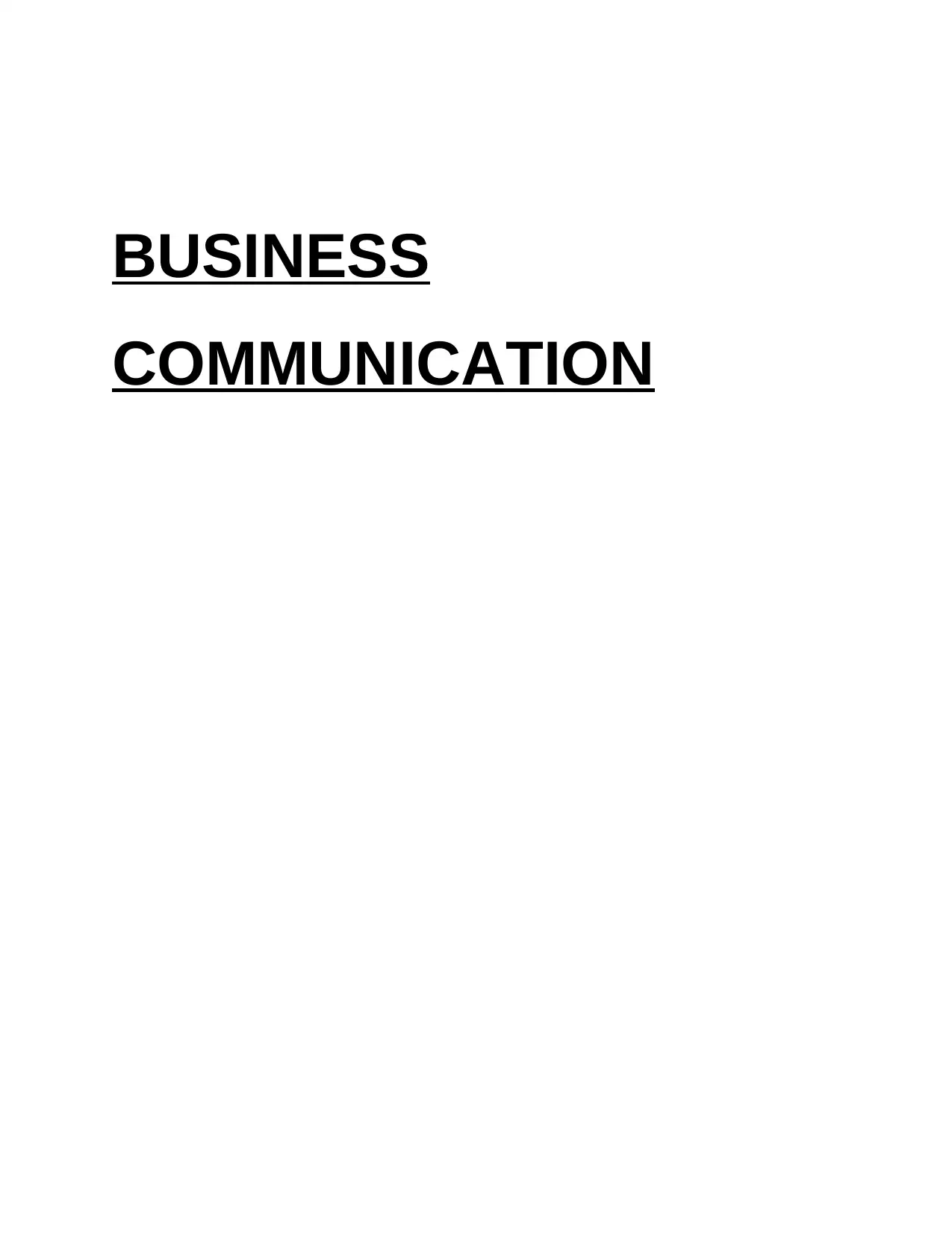
BUSINESS
COMMUNICATION
COMMUNICATION
Paraphrase This Document
Need a fresh take? Get an instant paraphrase of this document with our AI Paraphraser
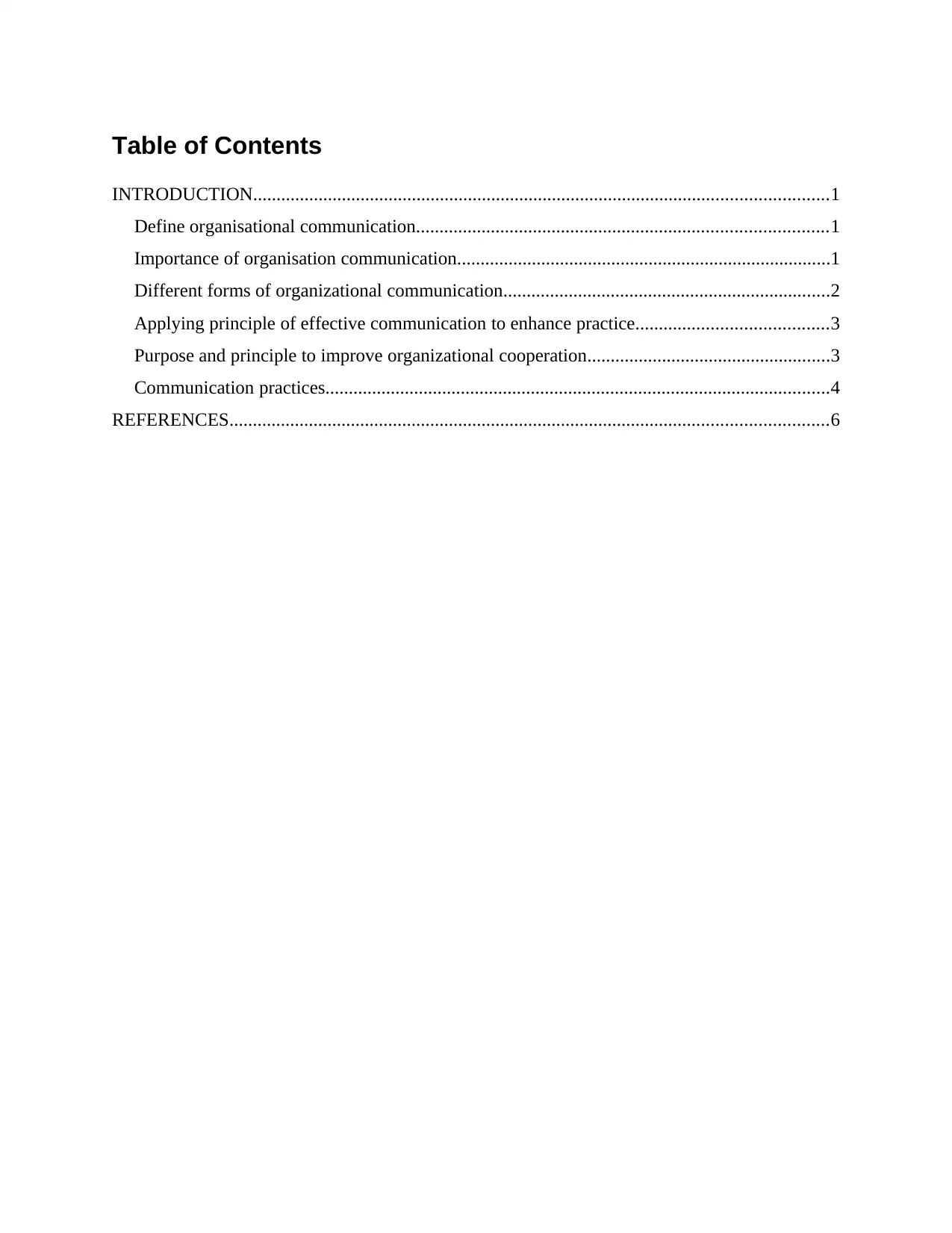
Table of Contents
INTRODUCTION...........................................................................................................................1
Define organisational communication........................................................................................1
Importance of organisation communication................................................................................1
Different forms of organizational communication......................................................................2
Applying principle of effective communication to enhance practice.........................................3
Purpose and principle to improve organizational cooperation....................................................3
Communication practices............................................................................................................4
REFERENCES................................................................................................................................6
INTRODUCTION...........................................................................................................................1
Define organisational communication........................................................................................1
Importance of organisation communication................................................................................1
Different forms of organizational communication......................................................................2
Applying principle of effective communication to enhance practice.........................................3
Purpose and principle to improve organizational cooperation....................................................3
Communication practices............................................................................................................4
REFERENCES................................................................................................................................6
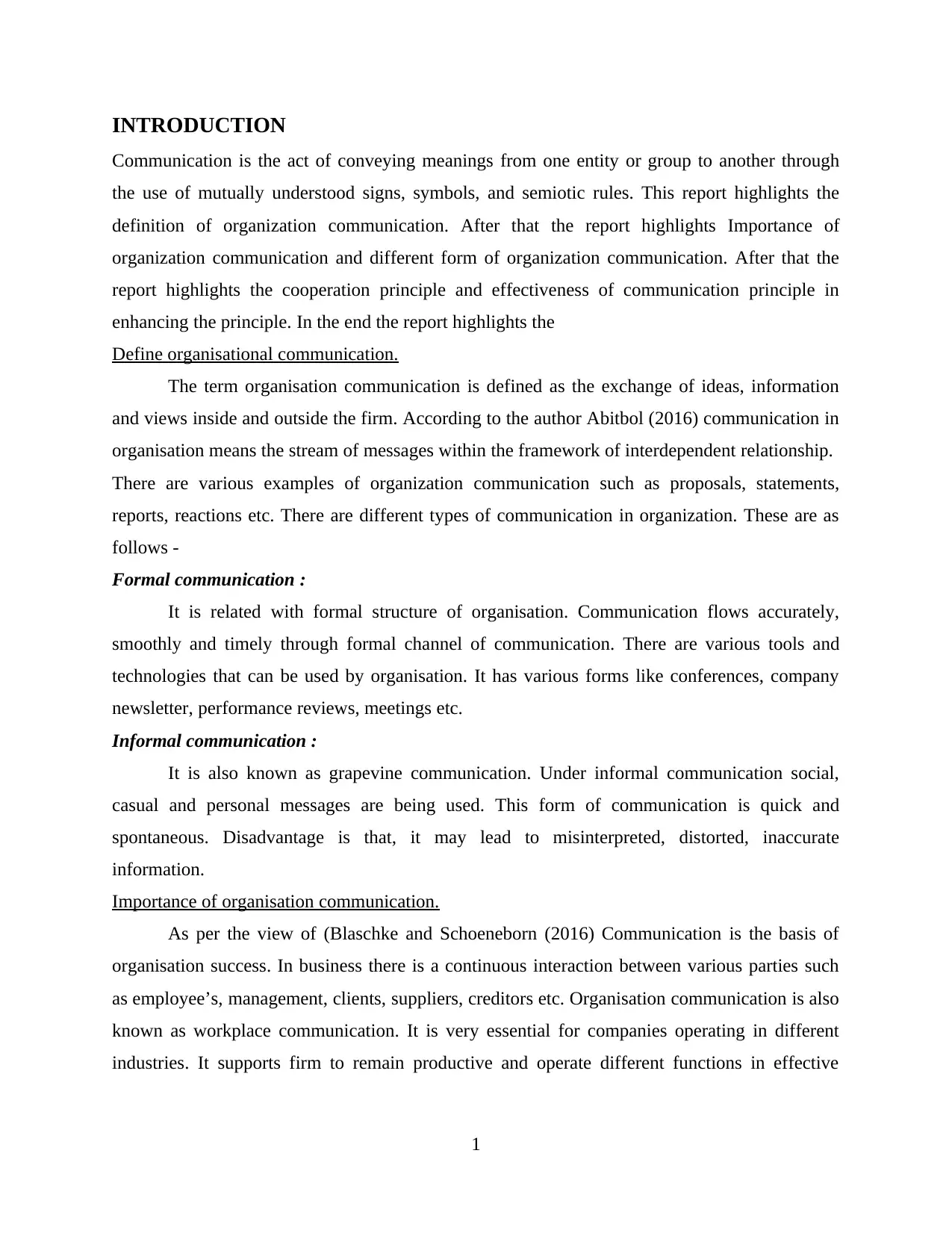
INTRODUCTION
Communication is the act of conveying meanings from one entity or group to another through
the use of mutually understood signs, symbols, and semiotic rules. This report highlights the
definition of organization communication. After that the report highlights Importance of
organization communication and different form of organization communication. After that the
report highlights the cooperation principle and effectiveness of communication principle in
enhancing the principle. In the end the report highlights the
Define organisational communication.
The term organisation communication is defined as the exchange of ideas, information
and views inside and outside the firm. According to the author Abitbol (2016) communication in
organisation means the stream of messages within the framework of interdependent relationship.
There are various examples of organization communication such as proposals, statements,
reports, reactions etc. There are different types of communication in organization. These are as
follows -
Formal communication :
It is related with formal structure of organisation. Communication flows accurately,
smoothly and timely through formal channel of communication. There are various tools and
technologies that can be used by organisation. It has various forms like conferences, company
newsletter, performance reviews, meetings etc.
Informal communication :
It is also known as grapevine communication. Under informal communication social,
casual and personal messages are being used. This form of communication is quick and
spontaneous. Disadvantage is that, it may lead to misinterpreted, distorted, inaccurate
information.
Importance of organisation communication.
As per the view of (Blaschke and Schoeneborn (2016) Communication is the basis of
organisation success. In business there is a continuous interaction between various parties such
as employee’s, management, clients, suppliers, creditors etc. Organisation communication is also
known as workplace communication. It is very essential for companies operating in different
industries. It supports firm to remain productive and operate different functions in effective
1
Communication is the act of conveying meanings from one entity or group to another through
the use of mutually understood signs, symbols, and semiotic rules. This report highlights the
definition of organization communication. After that the report highlights Importance of
organization communication and different form of organization communication. After that the
report highlights the cooperation principle and effectiveness of communication principle in
enhancing the principle. In the end the report highlights the
Define organisational communication.
The term organisation communication is defined as the exchange of ideas, information
and views inside and outside the firm. According to the author Abitbol (2016) communication in
organisation means the stream of messages within the framework of interdependent relationship.
There are various examples of organization communication such as proposals, statements,
reports, reactions etc. There are different types of communication in organization. These are as
follows -
Formal communication :
It is related with formal structure of organisation. Communication flows accurately,
smoothly and timely through formal channel of communication. There are various tools and
technologies that can be used by organisation. It has various forms like conferences, company
newsletter, performance reviews, meetings etc.
Informal communication :
It is also known as grapevine communication. Under informal communication social,
casual and personal messages are being used. This form of communication is quick and
spontaneous. Disadvantage is that, it may lead to misinterpreted, distorted, inaccurate
information.
Importance of organisation communication.
As per the view of (Blaschke and Schoeneborn (2016) Communication is the basis of
organisation success. In business there is a continuous interaction between various parties such
as employee’s, management, clients, suppliers, creditors etc. Organisation communication is also
known as workplace communication. It is very essential for companies operating in different
industries. It supports firm to remain productive and operate different functions in effective
1
⊘ This is a preview!⊘
Do you want full access?
Subscribe today to unlock all pages.

Trusted by 1+ million students worldwide
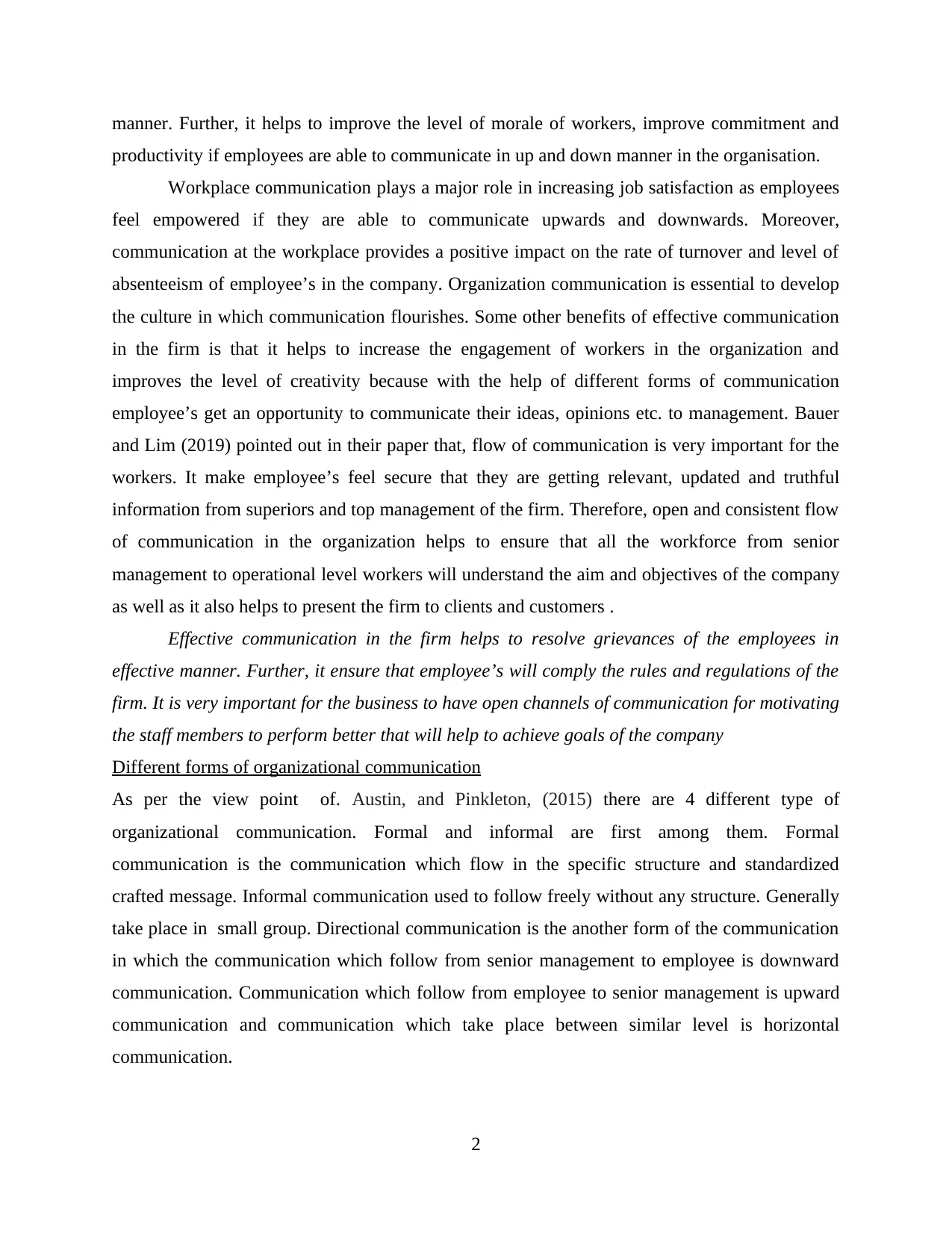
manner. Further, it helps to improve the level of morale of workers, improve commitment and
productivity if employees are able to communicate in up and down manner in the organisation.
Workplace communication plays a major role in increasing job satisfaction as employees
feel empowered if they are able to communicate upwards and downwards. Moreover,
communication at the workplace provides a positive impact on the rate of turnover and level of
absenteeism of employee’s in the company. Organization communication is essential to develop
the culture in which communication flourishes. Some other benefits of effective communication
in the firm is that it helps to increase the engagement of workers in the organization and
improves the level of creativity because with the help of different forms of communication
employee’s get an opportunity to communicate their ideas, opinions etc. to management. Bauer
and Lim (2019) pointed out in their paper that, flow of communication is very important for the
workers. It make employee’s feel secure that they are getting relevant, updated and truthful
information from superiors and top management of the firm. Therefore, open and consistent flow
of communication in the organization helps to ensure that all the workforce from senior
management to operational level workers will understand the aim and objectives of the company
as well as it also helps to present the firm to clients and customers .
Effective communication in the firm helps to resolve grievances of the employees in
effective manner. Further, it ensure that employee’s will comply the rules and regulations of the
firm. It is very important for the business to have open channels of communication for motivating
the staff members to perform better that will help to achieve goals of the company
Different forms of organizational communication
As per the view point of. Austin, and Pinkleton, (2015) there are 4 different type of
organizational communication. Formal and informal are first among them. Formal
communication is the communication which flow in the specific structure and standardized
crafted message. Informal communication used to follow freely without any structure. Generally
take place in small group. Directional communication is the another form of the communication
in which the communication which follow from senior management to employee is downward
communication. Communication which follow from employee to senior management is upward
communication and communication which take place between similar level is horizontal
communication.
2
productivity if employees are able to communicate in up and down manner in the organisation.
Workplace communication plays a major role in increasing job satisfaction as employees
feel empowered if they are able to communicate upwards and downwards. Moreover,
communication at the workplace provides a positive impact on the rate of turnover and level of
absenteeism of employee’s in the company. Organization communication is essential to develop
the culture in which communication flourishes. Some other benefits of effective communication
in the firm is that it helps to increase the engagement of workers in the organization and
improves the level of creativity because with the help of different forms of communication
employee’s get an opportunity to communicate their ideas, opinions etc. to management. Bauer
and Lim (2019) pointed out in their paper that, flow of communication is very important for the
workers. It make employee’s feel secure that they are getting relevant, updated and truthful
information from superiors and top management of the firm. Therefore, open and consistent flow
of communication in the organization helps to ensure that all the workforce from senior
management to operational level workers will understand the aim and objectives of the company
as well as it also helps to present the firm to clients and customers .
Effective communication in the firm helps to resolve grievances of the employees in
effective manner. Further, it ensure that employee’s will comply the rules and regulations of the
firm. It is very important for the business to have open channels of communication for motivating
the staff members to perform better that will help to achieve goals of the company
Different forms of organizational communication
As per the view point of. Austin, and Pinkleton, (2015) there are 4 different type of
organizational communication. Formal and informal are first among them. Formal
communication is the communication which flow in the specific structure and standardized
crafted message. Informal communication used to follow freely without any structure. Generally
take place in small group. Directional communication is the another form of the communication
in which the communication which follow from senior management to employee is downward
communication. Communication which follow from employee to senior management is upward
communication and communication which take place between similar level is horizontal
communication.
2
Paraphrase This Document
Need a fresh take? Get an instant paraphrase of this document with our AI Paraphraser
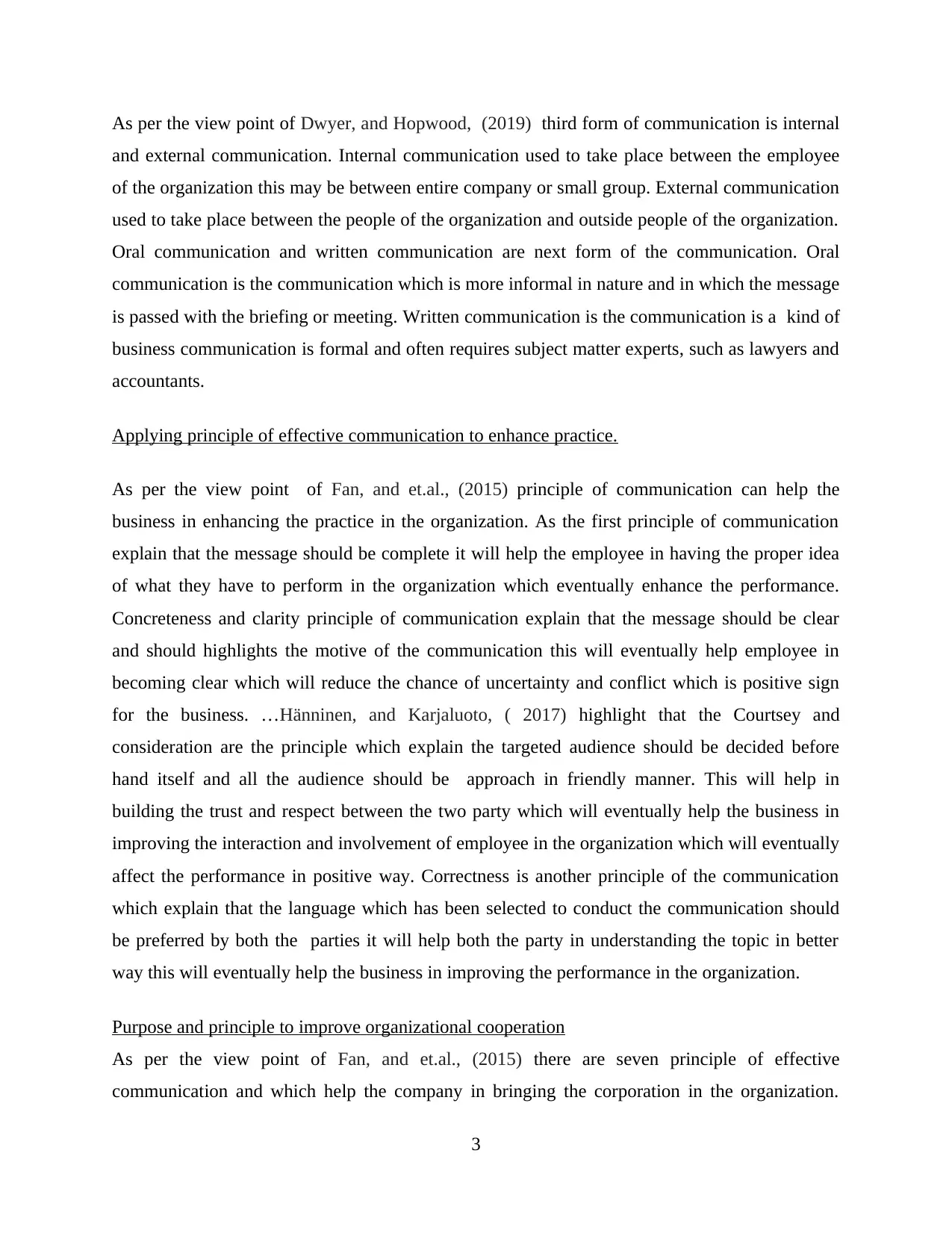
As per the view point of Dwyer, and Hopwood, (2019) third form of communication is internal
and external communication. Internal communication used to take place between the employee
of the organization this may be between entire company or small group. External communication
used to take place between the people of the organization and outside people of the organization.
Oral communication and written communication are next form of the communication. Oral
communication is the communication which is more informal in nature and in which the message
is passed with the briefing or meeting. Written communication is the communication is a kind of
business communication is formal and often requires subject matter experts, such as lawyers and
accountants.
Applying principle of effective communication to enhance practice.
As per the view point of Fan, and et.al., (2015) principle of communication can help the
business in enhancing the practice in the organization. As the first principle of communication
explain that the message should be complete it will help the employee in having the proper idea
of what they have to perform in the organization which eventually enhance the performance.
Concreteness and clarity principle of communication explain that the message should be clear
and should highlights the motive of the communication this will eventually help employee in
becoming clear which will reduce the chance of uncertainty and conflict which is positive sign
for the business. …Hänninen, and Karjaluoto, ( 2017) highlight that the Courtsey and
consideration are the principle which explain the targeted audience should be decided before
hand itself and all the audience should be approach in friendly manner. This will help in
building the trust and respect between the two party which will eventually help the business in
improving the interaction and involvement of employee in the organization which will eventually
affect the performance in positive way. Correctness is another principle of the communication
which explain that the language which has been selected to conduct the communication should
be preferred by both the parties it will help both the party in understanding the topic in better
way this will eventually help the business in improving the performance in the organization.
Purpose and principle to improve organizational cooperation
As per the view point of Fan, and et.al., (2015) there are seven principle of effective
communication and which help the company in bringing the corporation in the organization.
3
and external communication. Internal communication used to take place between the employee
of the organization this may be between entire company or small group. External communication
used to take place between the people of the organization and outside people of the organization.
Oral communication and written communication are next form of the communication. Oral
communication is the communication which is more informal in nature and in which the message
is passed with the briefing or meeting. Written communication is the communication is a kind of
business communication is formal and often requires subject matter experts, such as lawyers and
accountants.
Applying principle of effective communication to enhance practice.
As per the view point of Fan, and et.al., (2015) principle of communication can help the
business in enhancing the practice in the organization. As the first principle of communication
explain that the message should be complete it will help the employee in having the proper idea
of what they have to perform in the organization which eventually enhance the performance.
Concreteness and clarity principle of communication explain that the message should be clear
and should highlights the motive of the communication this will eventually help employee in
becoming clear which will reduce the chance of uncertainty and conflict which is positive sign
for the business. …Hänninen, and Karjaluoto, ( 2017) highlight that the Courtsey and
consideration are the principle which explain the targeted audience should be decided before
hand itself and all the audience should be approach in friendly manner. This will help in
building the trust and respect between the two party which will eventually help the business in
improving the interaction and involvement of employee in the organization which will eventually
affect the performance in positive way. Correctness is another principle of the communication
which explain that the language which has been selected to conduct the communication should
be preferred by both the parties it will help both the party in understanding the topic in better
way this will eventually help the business in improving the performance in the organization.
Purpose and principle to improve organizational cooperation
As per the view point of Fan, and et.al., (2015) there are seven principle of effective
communication and which help the company in bringing the corporation in the organization.
3
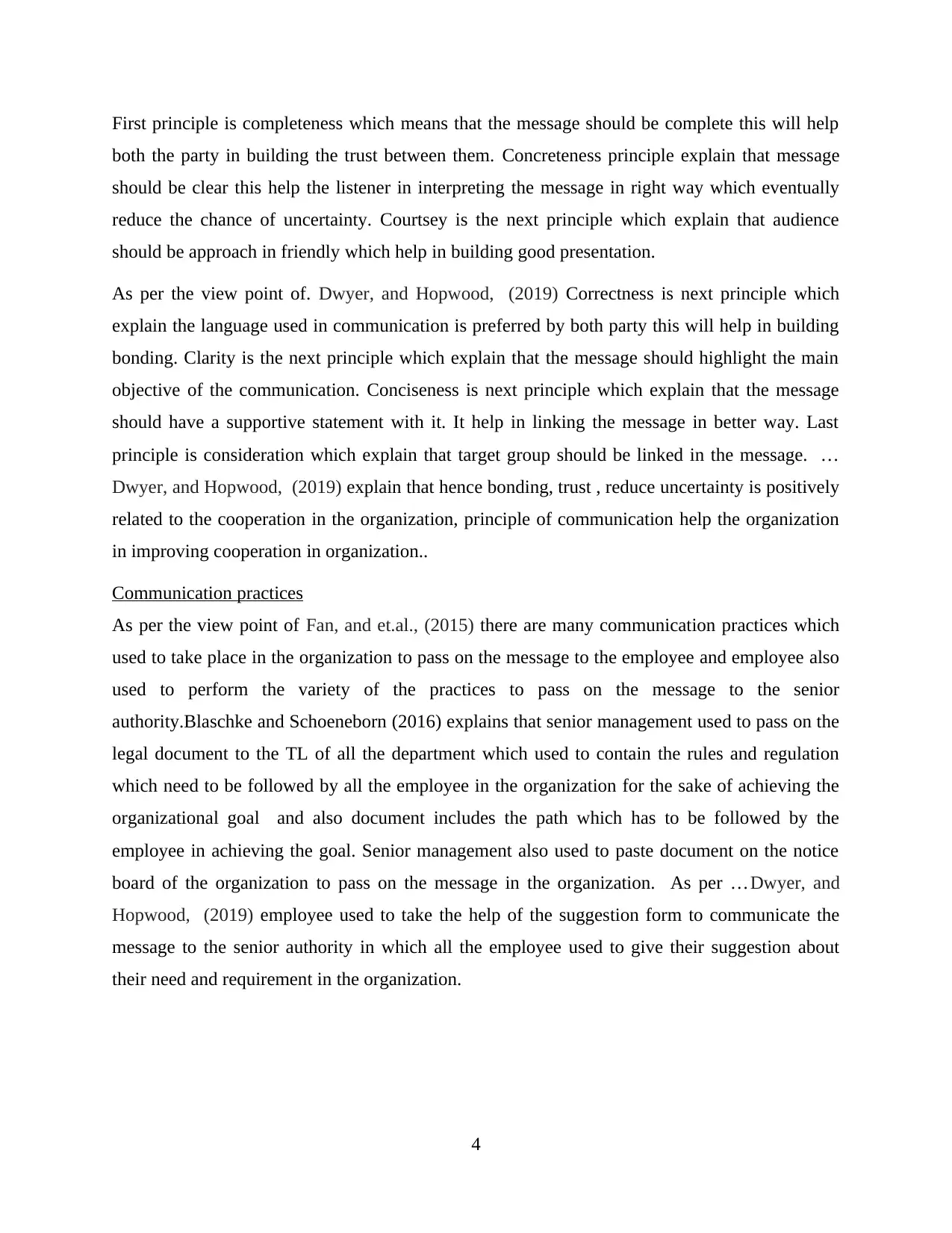
First principle is completeness which means that the message should be complete this will help
both the party in building the trust between them. Concreteness principle explain that message
should be clear this help the listener in interpreting the message in right way which eventually
reduce the chance of uncertainty. Courtsey is the next principle which explain that audience
should be approach in friendly which help in building good presentation.
As per the view point of. Dwyer, and Hopwood, (2019) Correctness is next principle which
explain the language used in communication is preferred by both party this will help in building
bonding. Clarity is the next principle which explain that the message should highlight the main
objective of the communication. Conciseness is next principle which explain that the message
should have a supportive statement with it. It help in linking the message in better way. Last
principle is consideration which explain that target group should be linked in the message. …
Dwyer, and Hopwood, (2019) explain that hence bonding, trust , reduce uncertainty is positively
related to the cooperation in the organization, principle of communication help the organization
in improving cooperation in organization..
Communication practices
As per the view point of Fan, and et.al., (2015) there are many communication practices which
used to take place in the organization to pass on the message to the employee and employee also
used to perform the variety of the practices to pass on the message to the senior
authority.Blaschke and Schoeneborn (2016) explains that senior management used to pass on the
legal document to the TL of all the department which used to contain the rules and regulation
which need to be followed by all the employee in the organization for the sake of achieving the
organizational goal and also document includes the path which has to be followed by the
employee in achieving the goal. Senior management also used to paste document on the notice
board of the organization to pass on the message in the organization. As per …Dwyer, and
Hopwood, (2019) employee used to take the help of the suggestion form to communicate the
message to the senior authority in which all the employee used to give their suggestion about
their need and requirement in the organization.
4
both the party in building the trust between them. Concreteness principle explain that message
should be clear this help the listener in interpreting the message in right way which eventually
reduce the chance of uncertainty. Courtsey is the next principle which explain that audience
should be approach in friendly which help in building good presentation.
As per the view point of. Dwyer, and Hopwood, (2019) Correctness is next principle which
explain the language used in communication is preferred by both party this will help in building
bonding. Clarity is the next principle which explain that the message should highlight the main
objective of the communication. Conciseness is next principle which explain that the message
should have a supportive statement with it. It help in linking the message in better way. Last
principle is consideration which explain that target group should be linked in the message. …
Dwyer, and Hopwood, (2019) explain that hence bonding, trust , reduce uncertainty is positively
related to the cooperation in the organization, principle of communication help the organization
in improving cooperation in organization..
Communication practices
As per the view point of Fan, and et.al., (2015) there are many communication practices which
used to take place in the organization to pass on the message to the employee and employee also
used to perform the variety of the practices to pass on the message to the senior
authority.Blaschke and Schoeneborn (2016) explains that senior management used to pass on the
legal document to the TL of all the department which used to contain the rules and regulation
which need to be followed by all the employee in the organization for the sake of achieving the
organizational goal and also document includes the path which has to be followed by the
employee in achieving the goal. Senior management also used to paste document on the notice
board of the organization to pass on the message in the organization. As per …Dwyer, and
Hopwood, (2019) employee used to take the help of the suggestion form to communicate the
message to the senior authority in which all the employee used to give their suggestion about
their need and requirement in the organization.
4
⊘ This is a preview!⊘
Do you want full access?
Subscribe today to unlock all pages.

Trusted by 1+ million students worldwide
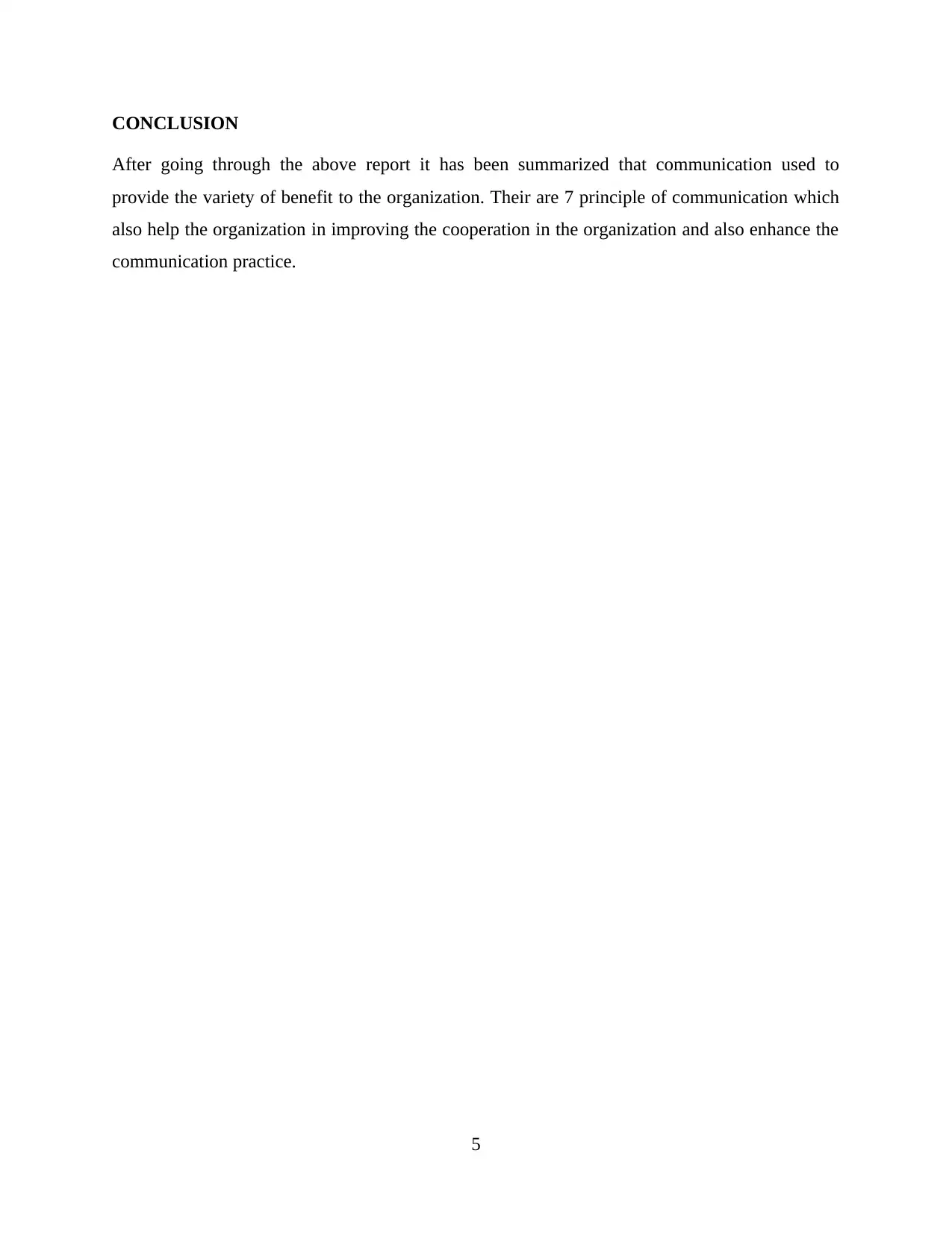
CONCLUSION
After going through the above report it has been summarized that communication used to
provide the variety of benefit to the organization. Their are 7 principle of communication which
also help the organization in improving the cooperation in the organization and also enhance the
communication practice.
5
After going through the above report it has been summarized that communication used to
provide the variety of benefit to the organization. Their are 7 principle of communication which
also help the organization in improving the cooperation in the organization and also enhance the
communication practice.
5
Paraphrase This Document
Need a fresh take? Get an instant paraphrase of this document with our AI Paraphraser
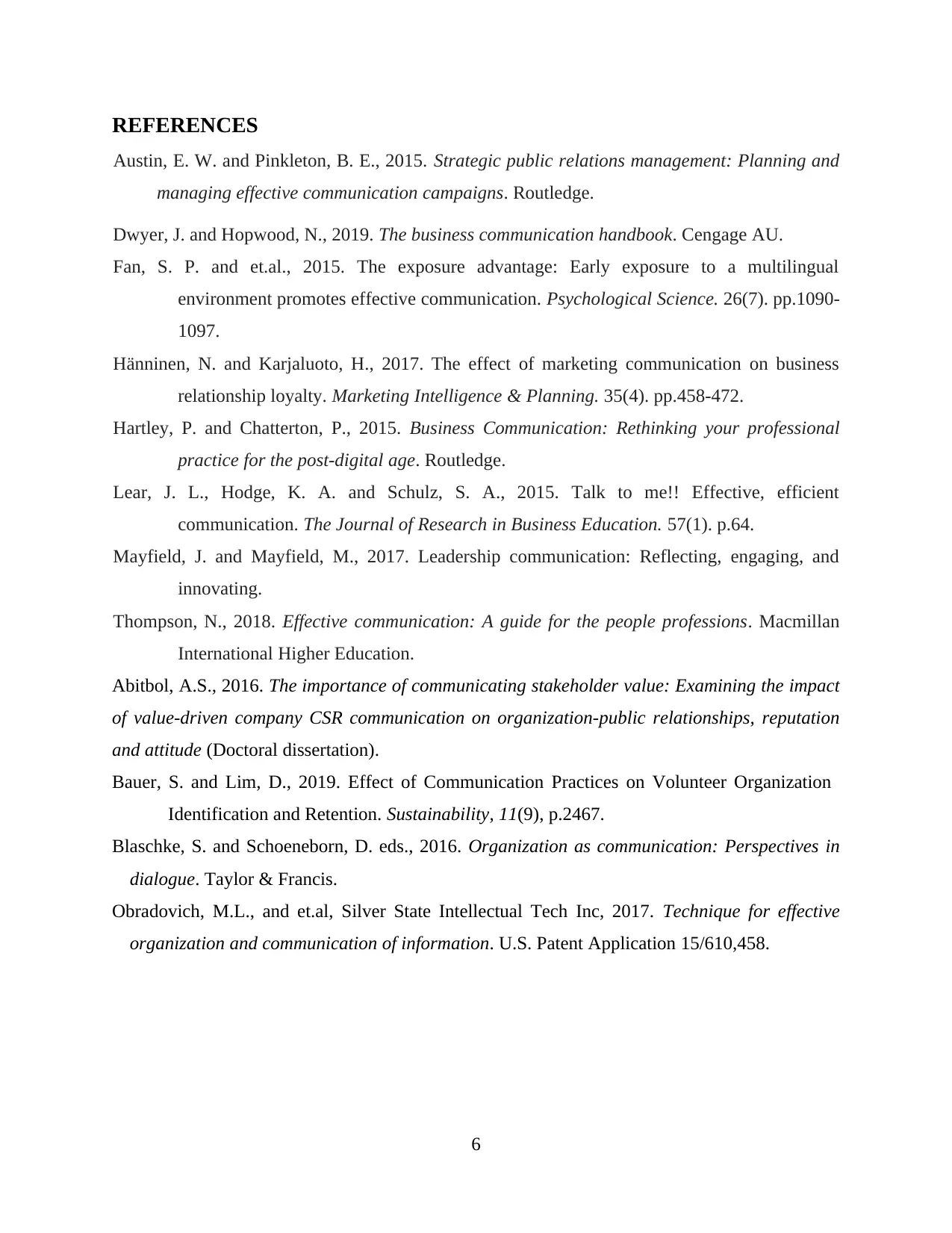
REFERENCES
Austin, E. W. and Pinkleton, B. E., 2015. Strategic public relations management: Planning and
managing effective communication campaigns. Routledge.
Dwyer, J. and Hopwood, N., 2019. The business communication handbook. Cengage AU.
Fan, S. P. and et.al., 2015. The exposure advantage: Early exposure to a multilingual
environment promotes effective communication. Psychological Science. 26(7). pp.1090-
1097.
Hänninen, N. and Karjaluoto, H., 2017. The effect of marketing communication on business
relationship loyalty. Marketing Intelligence & Planning. 35(4). pp.458-472.
Hartley, P. and Chatterton, P., 2015. Business Communication: Rethinking your professional
practice for the post-digital age. Routledge.
Lear, J. L., Hodge, K. A. and Schulz, S. A., 2015. Talk to me!! Effective, efficient
communication. The Journal of Research in Business Education. 57(1). p.64.
Mayfield, J. and Mayfield, M., 2017. Leadership communication: Reflecting, engaging, and
innovating.
Thompson, N., 2018. Effective communication: A guide for the people professions. Macmillan
International Higher Education.
Abitbol, A.S., 2016. The importance of communicating stakeholder value: Examining the impact
of value-driven company CSR communication on organization-public relationships, reputation
and attitude (Doctoral dissertation).
Bauer, S. and Lim, D., 2019. Effect of Communication Practices on Volunteer Organization
Identification and Retention. Sustainability, 11(9), p.2467.
Blaschke, S. and Schoeneborn, D. eds., 2016. Organization as communication: Perspectives in
dialogue. Taylor & Francis.
Obradovich, M.L., and et.al, Silver State Intellectual Tech Inc, 2017. Technique for effective
organization and communication of information. U.S. Patent Application 15/610,458.
6
Austin, E. W. and Pinkleton, B. E., 2015. Strategic public relations management: Planning and
managing effective communication campaigns. Routledge.
Dwyer, J. and Hopwood, N., 2019. The business communication handbook. Cengage AU.
Fan, S. P. and et.al., 2015. The exposure advantage: Early exposure to a multilingual
environment promotes effective communication. Psychological Science. 26(7). pp.1090-
1097.
Hänninen, N. and Karjaluoto, H., 2017. The effect of marketing communication on business
relationship loyalty. Marketing Intelligence & Planning. 35(4). pp.458-472.
Hartley, P. and Chatterton, P., 2015. Business Communication: Rethinking your professional
practice for the post-digital age. Routledge.
Lear, J. L., Hodge, K. A. and Schulz, S. A., 2015. Talk to me!! Effective, efficient
communication. The Journal of Research in Business Education. 57(1). p.64.
Mayfield, J. and Mayfield, M., 2017. Leadership communication: Reflecting, engaging, and
innovating.
Thompson, N., 2018. Effective communication: A guide for the people professions. Macmillan
International Higher Education.
Abitbol, A.S., 2016. The importance of communicating stakeholder value: Examining the impact
of value-driven company CSR communication on organization-public relationships, reputation
and attitude (Doctoral dissertation).
Bauer, S. and Lim, D., 2019. Effect of Communication Practices on Volunteer Organization
Identification and Retention. Sustainability, 11(9), p.2467.
Blaschke, S. and Schoeneborn, D. eds., 2016. Organization as communication: Perspectives in
dialogue. Taylor & Francis.
Obradovich, M.L., and et.al, Silver State Intellectual Tech Inc, 2017. Technique for effective
organization and communication of information. U.S. Patent Application 15/610,458.
6
1 out of 8
Related Documents
Your All-in-One AI-Powered Toolkit for Academic Success.
+13062052269
info@desklib.com
Available 24*7 on WhatsApp / Email
![[object Object]](/_next/static/media/star-bottom.7253800d.svg)
Unlock your academic potential
Copyright © 2020–2025 A2Z Services. All Rights Reserved. Developed and managed by ZUCOL.





